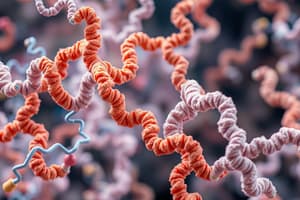Podcast
Questions and Answers
What is the primary function of enzymes in protein molecules?
What is the primary function of enzymes in protein molecules?
- Store genetic information
- Provide structural support
- Transport oxygen in the blood
- Catalyze biochemical reactions (correct)
Which type of protein is primarily responsible for regulating physiological processes?
Which type of protein is primarily responsible for regulating physiological processes?
- Structural proteins
- Transport proteins
- Enzymes
- Signaling proteins (correct)
In protein structure, which level describes the sequence of amino acids in a polypeptide chain?
In protein structure, which level describes the sequence of amino acids in a polypeptide chain?
- Primary structure (correct)
- Tertiary structure
- Secondary structure
- Quaternary structure
What role do membrane transporters fulfill in protein function?
What role do membrane transporters fulfill in protein function?
What distinguishes structural proteins from storage proteins?
What distinguishes structural proteins from storage proteins?
What characteristic of the peptide bond affects the rotation of amino acids in a polypeptide chain?
What characteristic of the peptide bond affects the rotation of amino acids in a polypeptide chain?
How are proteins structured in terms of their polypeptide arrangement?
How are proteins structured in terms of their polypeptide arrangement?
Which group in an amino acid contributes to its unique chemical properties?
Which group in an amino acid contributes to its unique chemical properties?
What type of reaction forms a peptide bond between two amino acids?
What type of reaction forms a peptide bond between two amino acids?
What are the two ends of a polypeptide chain called?
What are the two ends of a polypeptide chain called?
What role does the carboxyl group play when two amino acids bond?
What role does the carboxyl group play when two amino acids bond?
Which statement correctly describes the sequence of amino acids in proteins?
Which statement correctly describes the sequence of amino acids in proteins?
Which part of the amino acid structure remains the same across all amino acids?
Which part of the amino acid structure remains the same across all amino acids?
What is the primary factor that drives a protein into its tertiary structure?
What is the primary factor that drives a protein into its tertiary structure?
Which of the following statements is true regarding quaternary structure?
Which of the following statements is true regarding quaternary structure?
Which structural level of protein is characterized by alpha helices and beta-pleated sheets?
Which structural level of protein is characterized by alpha helices and beta-pleated sheets?
What is the effect called when proteins are fully unfolded?
What is the effect called when proteins are fully unfolded?
The arrangement of subunits in a protein is referred to as its what?
The arrangement of subunits in a protein is referred to as its what?
What determines the final folding of a protein?
What determines the final folding of a protein?
Which type of interaction is NOT primarily responsible for maintaining tertiary structure?
Which type of interaction is NOT primarily responsible for maintaining tertiary structure?
In the β-pleated sheet structure, how are the amino acids connected?
In the β-pleated sheet structure, how are the amino acids connected?
What determines the primary structure of a protein?
What determines the primary structure of a protein?
Which structure of a protein forms coils or regular shapes due to hydrogen bonding?
Which structure of a protein forms coils or regular shapes due to hydrogen bonding?
In terms of amino acids, how is an oligopeptide defined?
In terms of amino acids, how is an oligopeptide defined?
What type of bond is primarily responsible for the formation of alpha helices in proteins?
What type of bond is primarily responsible for the formation of alpha helices in proteins?
What is impacted by a slight change in the amino acid sequence of a protein?
What is impacted by a slight change in the amino acid sequence of a protein?
What is the correct definition of a tripeptide?
What is the correct definition of a tripeptide?
Which of the following is not a function of the protein shape?
Which of the following is not a function of the protein shape?
What is the consequence of polar groups in the main chain of a protein?
What is the consequence of polar groups in the main chain of a protein?
Flashcards are hidden until you start studying
Study Notes
Organic Molecules: Proteins
- Proteins are large, complex molecules composed of long chains of smaller units called amino acids.
- Essential for structure, function, and regulation of tissues and organs in the body.
Four Levels of Protein Structure
-
Primary Structure:
- Specific sequence of amino acids determined by genetic information (DNA).
-
Secondary Structure:
- Involves hydrogen bonding between backbone components, resulting in structures like alpha (α) helices and beta (β) pleated sheets.
-
Tertiary Structure:
- The overall three-dimensional shape of the protein, driven by interactions among side chains (R groups), especially hydrophobic interactions.
-
Quaternary Structure:
- Formation of a functional protein from two or more polypeptide chains (subunits), which may be identical or different (e.g., hemoglobin's structure).
Amino Acids: Building Blocks of Proteins
- There are 20 different amino acids, which each possess a central carbon, amino group, carboxyl group, hydrogen atom, and a variable side chain (R group).
- The unique properties of each amino acid arise from its side chain, contributing to protein structure and function.
Peptide Bonds and Polymerization
- Peptide bonds form between amino acids through a condensation reaction, linking the amino group of one to the carboxyl group of another, releasing a water molecule.
- Chains of amino acids are classified as follows:
- Dipeptide (2 amino acids)
- Tripeptide (3 amino acids)
- Oligopeptide (4-10 amino acids)
- Polypeptide (more than 10 amino acids)
Protein Functions
- Enzymes: Catalyze biochemical reactions.
- Structural proteins: Provide stability and movement (e.g., keratin in hair).
- Signaling proteins: Control physiological processes (e.g., hormones).
- Receptor proteins: Respond to chemical signals.
- Membrane transporters: Regulate substance passage across membranes.
- Storage proteins: Store amino acids for future use.
- Transport proteins: Carry substances within the organism.
- Gene regulatory proteins: Influence gene expression rates.
Importance of Protein Shape
- The specific shape of a protein is crucial for its function; slight changes in amino acid sequence can significantly affect its structure and capabilities.
- Secondary structures result from hydrogen bonding, while the tertiary structure is determined by the nature of the amino acid side groups.
Summary of Protein Structure Mechanisms
- Assembly Process: Primary structure (sequence), Secondary structure (hydrogen bonding), Tertiary structure (folding), and Quaternary structure (interactions between polypeptides).
Studying That Suits You
Use AI to generate personalized quizzes and flashcards to suit your learning preferences.




